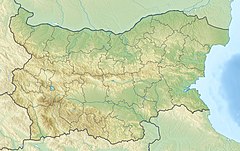Magura Cave
Пещера Магурата | |
 Cave drawings in the Magura Cave | |
 Location in Bulgaria | |
| Location | Near Rabisha village, Belogradchik town, Belogradchik municipality |
|---|---|
| Region | Vidin Province, Bulgaria |
| Coordinates | 43°43′40″N 22°34′58″E / 43.72778°N 22.58278°ECoordinates: 43°43′40″N 22°34′58″E / 43.72778°N 22.58278°E |
The prehistoric wall paintings of Magura have great resemblance with those of the Grotta dei Cervi in Italy, which are of exceptional expression and artistic depth and are considered the most significant works of art of the European Post-Paleolithic era.[1]
Guided visits are conducted by the staff of Belogradchik municipality, to which the management of the cave was transferred in 2012 by the Bulgarian Council of Ministers.
In 1984 the site was induced into UNESCO's tentative list of World Heritage.[2]
Description[]
Fauna[]
Bones from prehistoric species like cave bear, cave hyena, fox, wolf, wild cat and otter have been discovered in the Magura Cave. Today, constant inhabitants of the cave is the collembola, as well as four types of bats (greater and lesser horseshoe bat, greater mouse-eared bat and Schreibers's bat or also called common bent-wing bat).
Paintings[]

Cave paintings dating from the Epipaleolithic, late Neolithic, Eneolithic and early Bronze Age decorate some of the cave's walls. The paintings have been estimated to be made between 10.000 and 8.000 years ago. The drawings represent important events of the society that had occupied the Magura Cave: religious ceremonies, hunting scenes and depictions of deities which are unique on the Balkan peninsula. The Fertility Dance and the Hunting Ceremony rank among the most noteworthy paintings.
One grouping from the Bronze Age has been interpreted as a solar calendar. According to Alexey Stoev and Penka Vlaykova Stoeva Bronze Age "paintings of staggered black and white squares used to count the days in the calendar month permit to describe fairly accurately the number of days in the solar tropical year (Stoev and Muglova 1999). The cave paintings allowed storing information about regional solar calendar, customs, religious festivals, and rituals of the society the earliest such representation yet discovered in Europe."[3]
Contemporary imitations of possible fertility rites are reported — inscriptions in Latin and paintings made by treasure-hunters. The medium used to create the art was bat guano.[4] More than 750 images have been identified.
Painted signs can be organised into four thematic groups: anthropomorphic, zoomorphic, geometric, and symbolic (astronomic?) figures.[5] For the first group, there are bitriangular silhouettes with raised rounded arms (females with a sort of a waist bow, males with legs and sex like a trident, sometimes stylised like a "bottle opener"), archers, ithyphallic figures, copula, linear schematic anthropomorphic figures with raised arms (sometimes like dancing) and "fungiforms". Regarding zoomorphic items, there are caprids, bovids, dogs, "ostrich-like" animals (big birds) and schematic linear quadrupeds. Geometric signs show T-shaped figures, vertical parallel lines, horizontal zigzags, vertical parallel zigzags, branch-like or tree-like figures, chessboard patterns, rhombi, horizontal stair-like patterns, crossed networks, honeycomb networks and crossed circles. Few rayed circle figures, mainly the two unica of the so-called calendar scene, likely represent a sun depiction.[6]
Taking count of some associated figures, it is possible to recognize dancing, hunting, and mating scenes. In the so-called Cult Hall a large horizontal dance and hunting scene is depicted, arranged in two main rows: these are the best known and most reproduced Magura Cave images.
Access to the area of the paintings is restricted in an effort to preserve them.[7] Before 1993, the cave wasn't protected and there was free access to all. For this reason, some of the drawings have been vandalised and there are scratches on the walls. The cave is now open to the public all year round although the drawings can be seen only with the presence of a tour guide and the payment of a fee.
References[]
- ^ "Bulgarian rock art: the Magura Cave paintings". TRACCE Online Rock Art Bulletin. November 19, 2014. Retrieved 21 Nov 2014.
- ^ "The Magoura Cave with drawings from the bronze age". UNESCO World Heritage Centre. Retrieved 16 May 2013.
- ^ Stoev, Alexey; Maglova, Penka (2014), "Astronomy in the Bulgarian Neolithic", in Ruggles, Clive L. N. (ed.), The Handbook of Archaeoastronomy and Ethnoastronomy, New York: Springer, pp. 1377–1384, ISBN 978-1-4614-6140-1
- ^ Bahn, Paul G. (1998). The Cambridge Illustrated History of Prehistoric Art (1. publ. ed.). Cambridge: Cambridge Univ. Press. pp. 108–109. ISBN 0521454735.
- ^ Arcà, Andrea (November 19, 2014). "Bulgarian rock art: the Magura Cave paintings". TRACCE Online Rock Art Bulletin. Retrieved 21 Nov 2014.
- ^ "An excerpt of my Magura cave paintings study - The origin of the force". kikowsky_eng. November 1, 2011. Retrieved September 16, 2016.
- ^ "Bulgaria Magura Cave Paintings Exhibited for First Time". Novinite.com. March 18, 2009. Retrieved 17 May 2013.
External links[]
| Wikimedia Commons has media related to Magura Cave. |
| Wikibooks has a book on the topic of: The cave painting in Magura Cave |
- The Magura Cave, at tourism site Bulgariatravel.org
- Pictures from the Magura Cave
- Bulgarian rock art: the Magura Cave paintings, paper on TRACCE Online Rock Art Bulletin
- Magura Cave photo gallery, 45 pictures
- Caves of Bulgaria
- Balkan mountains
- Landforms of Vidin Province
- Tourist attractions in Vidin Province
- Belogradchik Municipality
- Archaeological sites in Bulgaria
- History of Vidin Province
- Limestone caves
- Show caves in Bulgaria
- Caves containing pictograms





